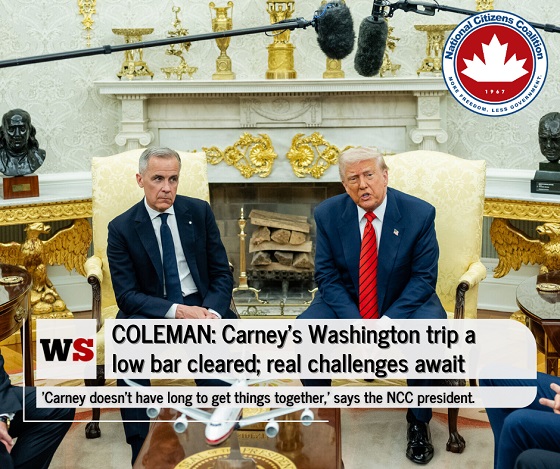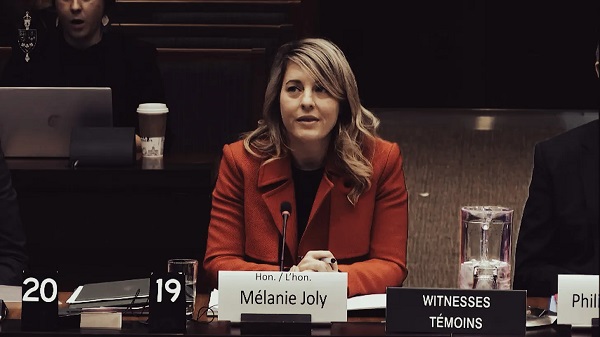Business
Real Challenges Await Carney

From the National Citizens Coalition
By Peter Coleman, President, National Citizens Coalition
Carney’s Washington Trip: A Low Bar Cleared, But Real Challenges Await
The legacy media circus surrounding Prime Minister Mark Carney’s recent trip to Washington was predictable, wasn’t it? The Liberal-subsidized press, ever eager to prop up their chosen darlings, couldn’t stop fawning over how Carney “stood up” to President Donald Trump. As someone who’s never been accused of waving a Liberal flag, I’ll admit it was refreshing to see a Canadian leader who could string two coherent sentences together without embarrassing us on the world stage. After years of Justin Trudeau sullying our nation with his very presence, Carney’s performance cleared the lowest of bars. But let’s not break out the champagne just yet.
NCC and Western Standard readers—hard-working folks who value straight talk over CBC’s syrupy narratives, or the Globe and Mail’s elitist drivel—know better than to judge a politician by their words. Carney’s entire election pitch boiled down to terrifying voters with a hyperbolic “Orange Man bad, vote for me” message. It was a message tailor-made for naive leftists glued to legacy media, blissfully unaware of the real world. Meanwhile, those of us reading outlets like this one, where ideas are challenged and truths are unearthed, saw through the bombast and the cynical “elbows up” campaign strategy, and we know to judge leaders by what they do, not what they say to get elected. On that front, Carney’s still got a steep hill to climb.
So let’s give credit where it’s due—not to Carney, but to Alberta Premier Danielle Smith. Her recent press conference was a masterclass in clarity and conviction, laying out conditions for a new relationship with a federal government that’s long treated Alberta with disdain. For too many in Ottawa, Alberta’s nothing more than a cash cow to prop up Quebec through equalization payments while dismissing the West’s reasonable concerns as backwater griping. Smith’s demands were practical and rooted in the reality that Alberta’s contributions deserve more respect, not contempt. So, how did the so-called “smartest guy in the room”—as Carney and his media cheerleaders love to proclaim—respond to these demands? Crickets. No answers, no action, just the same old Liberal sidestep.
Meanwhile, while Carney basks in the afterglow of his Washington photo-op, the world isn’t waiting for Canada to get its act together. As I write this, the United States and the United Kingdom have just announced the framework for a historic free trade agreement. Remember Carney’s campaign promises? He was supposed to be the guy securing “historic” trade deals with the UK and the EU. Yet here we are, watching the UK cozy up to the U.S. while Canada’s left on the sidelines. What happened? Could it be that Carney’s thinly veiled carbon tax obsession and climate change dogma—kept under wraps during the campaign—are already scaring off potential partners? Or perhaps our allies see what millions in Canada have already noticed: a leader surrounded by the same incompetent Trudeau-era cabinet, who may still be destined to recycle the same tired and destructive ideas that have held Canada back for a decade.
Time will tell, but the clock is ticking, and Canada’s still moving in slow motion. Carney will soon learn the hard way that governing is a far cry from glad-handing in Beijing, benefiting from President Trump’s election interference, or fear-mongering on the campaign trail. Most Canadians aren’t interested in more rhetoric; we want results. With our vast resources, we should be the richest country on Earth, yet for ten years, we’ve been sliding backward. Our economy is stagnant, our global influence is waning, and Ottawa’s obsession with centralized control and woke policies have left us ill-equipped to compete. The time for change isn’t tomorrow—it’s now.
Carney’s got a chance to prove he’s more than a slick operator, but he’s got to deliver. Alberta’s demands, as articulated by Smith, aren’t just a wishlist; they’re a pre-requisite to restoring fairness and unleashing our potential. Ignore them, and Carney risks alienating the real economic engine of this country. Canadians deserve better than another decade of mismanagement and excuses. Here at the National Citizens Coalition, we’ve been around since 1967, and we’ve seen governments come and go. Through it all, we’ve stayed true to our mission: advocating for freedom and common sense, and a Canada that lives up to its promise. Mark Carney is on notice—words won’t cut it anymore. It’s time to act.
But more than anything, it’s time for government to get out of the way.
Peter Coleman is the President of the National Citizens Coalition, Canada’s pioneer conservative non-profit advocacy group.
Business
No Jobs Clause: Liberals Under Fire Over Stellantis Deal in Fiery Committee Showdown

It was less of an industrial strategy and more of a cultural manifesto wrapped in a subsidy package… clause after clause mandates social goals: The “50-30 Challenge” pushes for 50% women and 30% underrepresented groups on boards, with detailed reporting on diversity metrics… But job protections? Squishy at best.
Folks, here’s why every Canadian should be boiling mad: Just two years ago, on May 2, 2023, Justin Trudeau’s Liberals were all grins and photo ops, announcing a whopping $15 billion deal with Stellantis to build the NextStar EV battery plant in Windsor, Ontario. Trudeau himself called it a “historic agreement” that would “create thousands of well-paying jobs” and position Canada as a leader in electric vehicles. But fast-forward to October 14, 2025, and Stellantis pulls the plug on Brampton: They’re shifting production of the Jeep Compass from the Ontario plant to Belvidere, Illinois, citing “market conditions” exacerbated by Donald Trump’s reinstated 25% tariffs on Canadian-made vehicles. As Reuters reported on November 3, 2025, those tariffs—slapped on earlier this year—made it untenable to keep building in Canada for the U.S. market. Result? 3,000 workers laid off indefinitely, a facility idled since February 2024, and billions in taxpayer subsidies looking like a sucker punch. Stellantis isn’t even hiding it; their press release that day admitted the move was to “optimize operations” amid tariff pressures, investing $600 million in Illinois instead.
It’s a question that should make every Canadian furious, particularly anyone who still believes that the government’s role is to defend the nation’s workers rather than sell them out to foreign multinationals under the guise of “green investment.” The Trudeau government—with a lot of ribbon-cutting, back-patting, and press conference confetti—told us this was a generational opportunity. Up to $15 billion of taxpayer money was pledged through a combination of federal and Ontario subsidies, a massive, glittering pile of cash dumped at the feet of a foreign company to secure so-called “green jobs” in the electric vehicle sector. Split two-thirds federal and one-third provincial, it’s tied to production incentives—paid per kilowatt-hour as batteries roll out, not upfront, per the redacted contract leaked by CBC on October 29, 2025. But that didn’t stop the Liberals from hyping it as a slam-dunk for Canada’s economy.
At the time, Liberal ministers paraded through Windsor and Brampton with photographers in tow, declaring that the NextStar EV battery plant and a retooled Brampton assembly line would solidify Canada’s future in the EV revolution. The Strategic Innovation Fund was rolled out like a magic wand—promising prosperity, sustainability, and, of course, “equity.” Not just for jobs, but for gender representation, for racial diversity on corporate boards, for net-zero targets. It was less of an industrial strategy and more of a cultural manifesto wrapped in a subsidy package. As revealed in the CBC-leaked documents, clause after clause mandates social goals: The “50-30 Challenge” pushes for 50% women and 30% underrepresented groups on boards, with detailed reporting on diversity metrics. Climate commitments? Baked in, with net-zero benchmarks. But job protections? Squishy at best.
But now, Stellantis is pulling up stakes in Brampton. They’re shipping production of the Jeep Compass south—to Illinois. The line is shutting down. Three thousand jobs are gone, and Ottawa’s response? A letter. A procedural dispute-resolution letter sent to Stellantis lawyers on November 3, 2025, with the government now claiming the company broke a “binding agreement.” As Industry Minister Mélanie Joly told the parliamentary committee that day, “We will start the 30-day period of the formal dispute resolution process in order to bring back production at the Stellantis Brampton facility.” She added, “These actions are not symbolic. They’re the direct consequence of the violation of clear commitments.” The same government that only weeks ago was hailing this deal as a model for the future now admits it may not even contain an enforceable jobs guarantee. The language is vague. The numbers are redacted. The accountability? Nonexistent.
The Industry Minister, Mélanie Joly, faced her grilling on Parliament Hill during a meeting of the House of Commons Standing Committee on Industry and Technology (INDU)—that exposed just how hollow this whole deal really was. Conservative MPs, including Raquel Dancho and Michael Guglielmo, demanded to see the clause. Which clause did Stellantis allegedly violate? What exactly was the commitment to Brampton? How many jobs were actually guaranteed? Was there a number? Was it enforceable? The Minister couldn’t—or wouldn’t—say. She deflected, pointed to redacted documents, and, when pressed about why the contract was packed with detailed social engineering mandates on board diversity but lacked hard job protections, accused her critics of being “against women.”
You can’t make this up.
Raquel Dancho, hammering in the core question that everyone watching already knew the answer to, asked,
“Was it 3,000 jobs that that SIF agreement with Brampton guaranteed?”
The minister responded like a bureaucratic ghost, floating just above the substance of the question.
“There are job guarantees in all the different contracts,” she said, “but you absolutely need to make sure that you see not only the contract… but also its amendment.”
Translation: Trust us. It’s in there somewhere. You just can’t see it.
Dancho pushed again: Where’s the number? Where’s the clause? The minister replied, “Clearly it is about protecting jobs. It is also about the production at the Brampton facility.” Not a single figure. Not a single line reference. Just the usual empty affirmation: “We care.”
Dancho didn’t let up. She cut through the fluff with brutal clarity:
“Surely there should be an explicit Canada-wide jobs guarantee. But we’re splitting hairs here. You’ve been evasive about the numbers… I’m not sure if you understand the magnitude of the money that you’ve committed.”
Then came the math:
“Over 647,000 full-time, two-parent Canadian families had to work an entire year to provide the $11 billion your government handed over to Stellantis. And still, there’s no explicit jobs guarantee.”
And when Michael Guglielmo followed up with the most damning observation of all—why are the clearest commitments in this contract about gender and racial equity quotas, not Canadian jobs?—the minister didn’t even deny it. She shot back with the cheap and predictable counterpunch:
“Are you against women being on boards?”
This is what it’s come to.
Instead of defending Canadian workers, the minister defends ideological clauses. Instead of admitting they cut a $15 billion cheque without a locked-down jobs guarantee, they imply that questioning the deal is somehow anti-diversity. These people don’t just miss the point—they refuse to even stand in the same room as the point.
Because the priority wasn’t jobs. It was ideology. The contract’s most detailed provisions weren’t about keeping Canadians employed—they were about the “50-30 challenge,” ensuring that Stellantis boards hit quotas: 50% women or non-binary individuals, 30% racialized, LGBTQ+, Indigenous, or disabled. These were enforceable clauses. Meanwhile, the 3,000 Brampton workers whose plant just shut down got… vibes.
That’s not economic strategy. That’s social engineering masquerading as industrial policy.
And now, when the jobs are gone, when Brampton is shuttered, when the workers are packing up their toolboxes and wondering how they’re going to pay their mortgage, the Liberals say they’re “launching a dispute-resolution process.” They sent a letter. They held a press conference. The Prime Minister, not present. The Minister, ducking behind amendments and redactions. And Canadians are left asking the only question that matters: Did we just get played?
Yes. We did.
The Liberals want you to believe this is just the price of doing business in a green economy. That global supply chains shift. That the transition to EVs is complicated. That we must continue to “work together.” But that’s not leadership. That’s surrender. The truth is, this wasn’t an industrial strategy—it was a $15 billion act of political performance art. A press release dressed up as policy. A parade of woke checkboxes signed into law while real, blue-collar livelihoods were used as bait.
And now we’re paying for it—not just in tax dollars, but in lost paychecks, empty factories, and shattered trust.
This is what happens when your government governs with hashtags instead of handshakes. When they negotiate with ideology, not leverage. When they cut billion-dollar deals and forget to actually protect the people they claim to represent.
Stellantis didn’t betray Brampton. The Liberal government did.
If there was a real deal—an actual, enforceable agreement that tied billions in taxpayer money to thousands of Canadian jobs—we’d be hearing about it nonstop. The Liberals wouldn’t be hiding behind redactions, amendments, and vague references to “linked contracts.” They’d be shouting from every podium: Here’s the clause. Here’s the violation. Here’s the money we’re clawing back. But instead, what do we get?
We get, “You’ll find it.”
We get, “It’s in the amendment.”
We get, “It’s commercially sensitive.”
It’s a shell game. A bureaucratic sleight of hand. Because the truth is, if this government had locked in a rock-solid guarantee, they’d be waving it in your face. They’d be naming names and quoting line numbers. But they can’t. Because it doesn’t exist. Or worse, because they were too arrogant or incompetent to include it in the first place.
And frankly, I’m not surprised. We’ve come to expect this from a Liberal government that governs by photo op and backpedals by committee. But what this is really about—what this entire spectacle reveals—is not just incompetence. It’s the desperate attempt to hide that incompetence from their own base. To maintain the illusion that they’re builders of the future while the factories go dark behind them.
They knew what they were doing. They just didn’t care who paid for it.
Business
Carney government’s first budget should signal end to crippling ‘climate’ policies

From the Fraser Institute
The Carney government will table its long-awaited first budget tooday. The vote on the budget is expected to be a confidence vote, so the stakes are high. Everyone is speculating about what’s to be in it. CBC, the Toronto Sun and Global News are all reading the tea leaves. And I hate to miss a tea party.
The budget is, naturally, going to have major implications for Canada’s economic indicators of debt, deficit, spending, governmental expansion/contraction, and so on. I’ll leave all that macroeconomics to my colleagues at Fraser Institute. But Prime Minister Carney has made some specific claims in my areas of specialty (environment, natural resources and regulation), and has made noises about Canada becoming an “energy superpower” and “building things” again. He’s also, in speeches leading up to the budget, re-affirmed that the Trudeau-era climate-change-centric, carbon-emission-control mindset is unchanged. The wording has changed, but the focus and predicates remain. Now though, rather than pounding on terms such as carbon, greenhouse and climate change, it’s all about Canadian policy being “responsible,” “sustainable,” “moral” and “equitable.”
Here’s what I’ll look for in the budget.
First, will the government dismantle or reform bills C-48, C-69 and the oil and gas emission cap—the three-pronged trident of death for major oil and gas development in Canada? Without this, it will be difficult to take any of his talk of energy superpower or natural resource trade renaissance seriously.
Second, will the government renounce or seriously reform the economically irrational, unattainable and crippling “net-zero 2050” anti-carbon agenda and shift Canada’s climate policy from emissions abatement to something potentially more attainable, such as adaptation and resilience building? Will it free Canada’s carbon natural resource economy to be the engine of Canadian prosperity and international competitiveness once again? Or keep Canada’s carbon (oil and gas) economy (and manufacturing economy) on a path toward extinction?
Third, will the government reset the tone of Canadian culture and defuse some of the adversarial relations with resource-rich provinces by acknowledging that Canada’s natural-resource economy has been, is now and must continue to be a cornerstone in Canada’s total economy? Or will it stick to the “net-zero” extinction process for carbon emissions, which will also be an extinction process for anything that requires substantial energy generation, and for the development of natural resources as the primary wealth engine of Canada? Will the government end the disdain for the role of Canada (and notably some of Canada’s western provinces) as a natural-resources export economy?
The budget will offer a window into the mind of Prime Minister Carney on the matter of natural resources in Canada’s economy and society. With global changes undermining the international carbon control regime and idee fixe, and with an understanding that Canada is on an economic precipice, there’s an opportunity here. Let’s hope Carney works to unshackle one of Canada’s greatest engines of economic progress—its energy and natural resource production, transformation, transportation, consumption and exportation.
Canadians could use the boost in quality of life that Canada’s natural resources could bring to current and future generations.
-

 Crime2 days ago
Crime2 days agoPublic Execution of Anti-Cartel Mayor in Michoacán Prompts U.S. Offer to Intervene Against Cartels
-

 Environment2 days ago
Environment2 days agoThe era of Climate Change Alarmism is over
-

 Aristotle Foundation2 days ago
Aristotle Foundation2 days agoB.C. government laid groundwork for turning private property into Aboriginal land
-

 Justice2 days ago
Justice2 days agoA Justice System That Hates Punishment Can’t Protect the Innocent
-

 Alberta1 day ago
Alberta1 day agoCanada’s heavy oil finds new fans as global demand rises
-

 Business1 day ago
Business1 day agoCarney government should retire misleading ‘G7’ talking point on economic growth
-

 Censorship Industrial Complex1 day ago
Censorship Industrial Complex1 day agoPro-freedom group warns Liberal bill could secretly cut off Canadians’ internet access
-

 Daily Caller1 day ago
Daily Caller1 day agoNigeria Would Welcome US Intervention In Massacre Of Christians By Islamic Terror Groups








